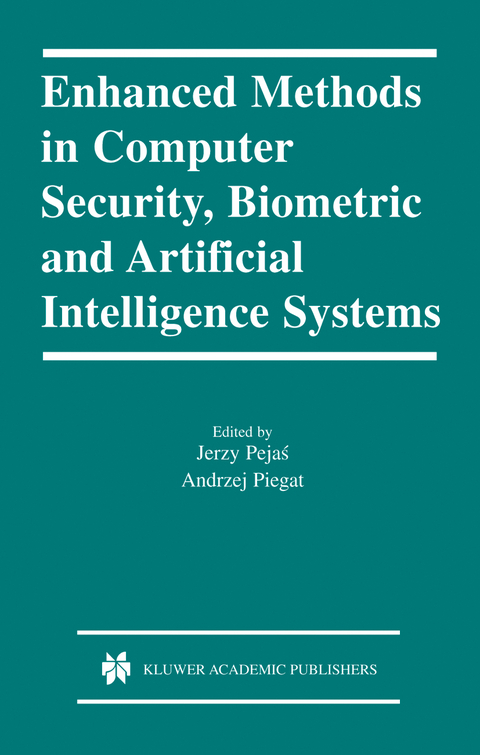
Enhanced Methods in Computer Security, Biometric and Artificial Intelligence Systems
Springer-Verlag New York Inc.
978-1-4020-7776-0 (ISBN)
Enhanced Methods in Computer Security, Biometric and Artificial Intelligence Systems contains over 30 contributions from leading European researchers showing the present state and future directions of computer science research.
"Methods of Artificial Intelligence and Intelligent Agents" contains 13 contributions analyzing such areas of AI as fuzzy set theory, predicate logic, neural networks, clustering, data mining and others. It also presents applications of AI as possible solutions for problems like firm bankruptcy, soil erosion, flight control and others.
"Information Technology Security" covers three important areas of security engineering in information systems: software security, public key infrastructure and the design of new cryptographic protocols and algorithms.
"Biometric Systems" comprises 11 contributions dealing with face picture analysis and recognition systems. This chapter focuses on known methods of biometric problem solution as well as the design of new models.
Information Technology Security.- How can we justify trust in software based systems?.- The capacity of ciphers fulfilling the accessibility of cryptograms.- Parallelization of the Data Encryption Standard (DES) algorithm.- Linked authenticated dictionaries for certificate status verification.- Integrated Payment System for Public Key Infrastructure Services.- Some methods of the analysis and risk assessment in the PKI system services providers.- VAST: Versatile Anonymous System for Web Users.- Cryptography and Steganography: teaching experience.- Analysis of non-linear pseudo-noise sequences.- Tool support for detecting defects in object-oriented models.- The Proposal of Protocol for Electronic Signature Creation in Public Environment.- On Arithmetic Subtraction Linear Approximation.- Secure Data Transmission via Modulation of the Chaotic Sequence Parameters.- Biometric Systems.- Some Advances and Challenges in Live Biometrics, Personnel Management, and Other “Human Being” Applications.- An environment for recognition systems modeling.- Modified Gradient Method for Face Localization.- Three stage face recognition algorithm for visitor identification system.- A New Approach for Hand-Palm Recognition.- An Experimental Criterion for Face Classification.- Contour Objects Recognition Based On UNL-Fourier Descriptors.- Sonar Image Simulation by Means of Ray Tracing and Image Processing.- The PCA Reconstruction Based Approach for Extending Facial Image Databases for Face Recognition Systems.- Investigation of fingerprint verification algorithm based on local centers method.- Czestochowa’s Precise Model of a Face Based on the Facial Asymmetry, Ophthalmogeometry, and Brain Asymmetry Phenomena: the Idea and Algorithm Sketch.- Methods of Artificial Intelligence andIntelligent Agents.- A fuzzy expert approach for comparing alternative end uses for requalification of contaminated sites.- Training assisting program with hybrid decision supporting system.- Numerical problems with evaluating the fractal dimension of real data.- Multi-stage ship control in a fuzzy environment.- Informative value of the possibilistic extension principle.- Intelligent Marine Control Systems.- How to deal with the data in a bankruptcy modelling.- Dependency Mining in Large Sets of Stock Market Trading Rules.- Choosing representative data items: Kohonen, Neural Gas or Mixture Model?.- Application of the Ant Colony Algorithm for the Path Planning.- Application of fuzzy logic for track corrector formation into flight simulator.- Algorithm for Automatic Definition of Validated and Non-Validated Region in Multi-Dimensional Space.- Adaptive simulation of separable dynamical systems in the neural network basis.- Improvement of the processors operating ratio in task scheduling using the deadline method.
| Erscheint lt. Verlag | 2.11.2004 |
|---|---|
| Zusatzinfo | XII, 396 p. |
| Verlagsort | New York, NY |
| Sprache | englisch |
| Maße | 155 x 235 mm |
| Themenwelt | Informatik ► Netzwerke ► Sicherheit / Firewall |
| Informatik ► Theorie / Studium ► Künstliche Intelligenz / Robotik | |
| ISBN-10 | 1-4020-7776-9 / 1402077769 |
| ISBN-13 | 978-1-4020-7776-0 / 9781402077760 |
| Zustand | Neuware |
| Haben Sie eine Frage zum Produkt? |
aus dem Bereich


